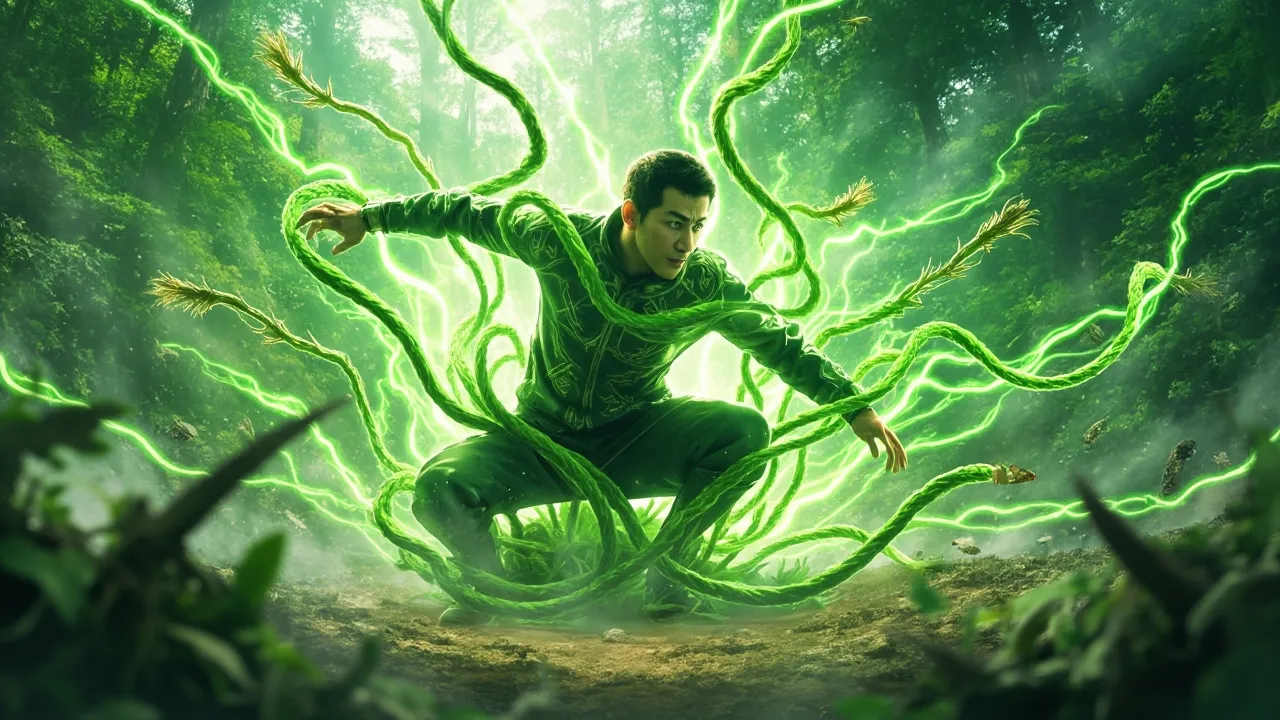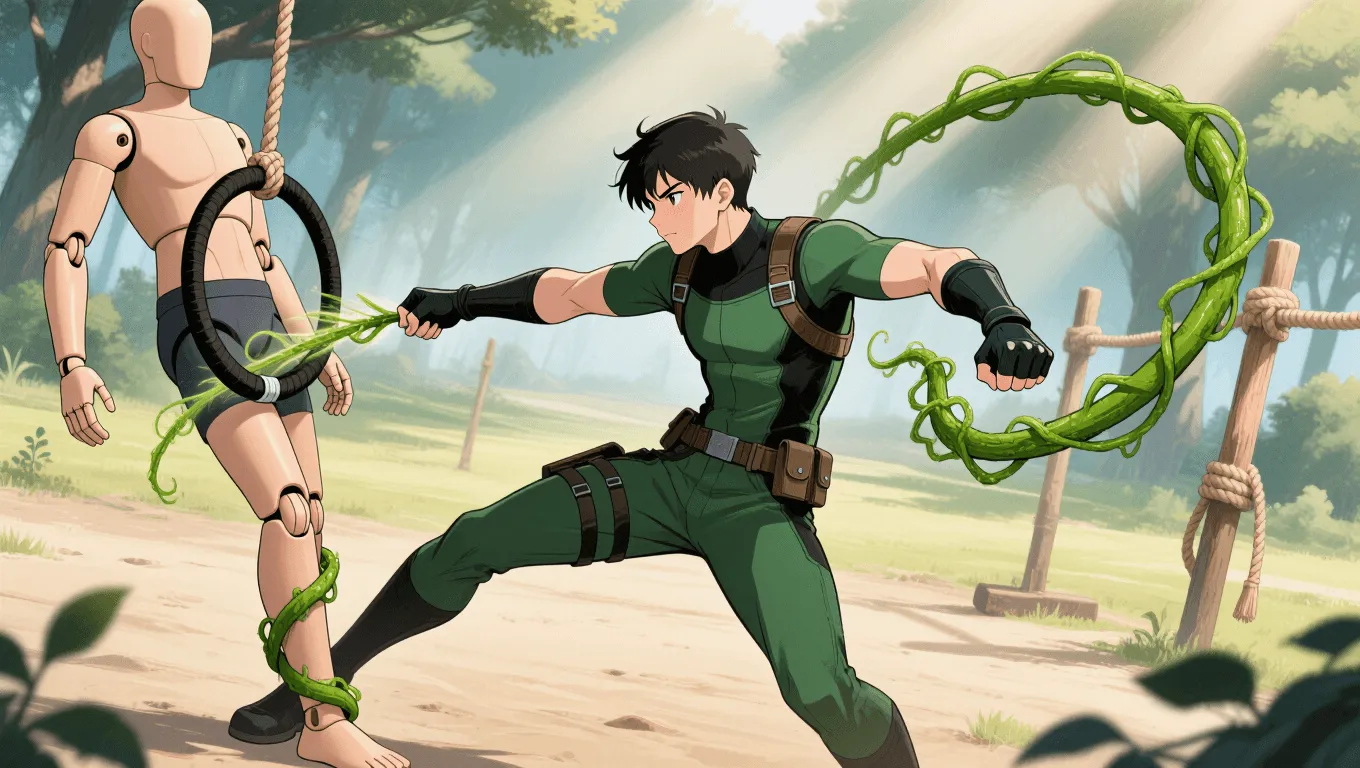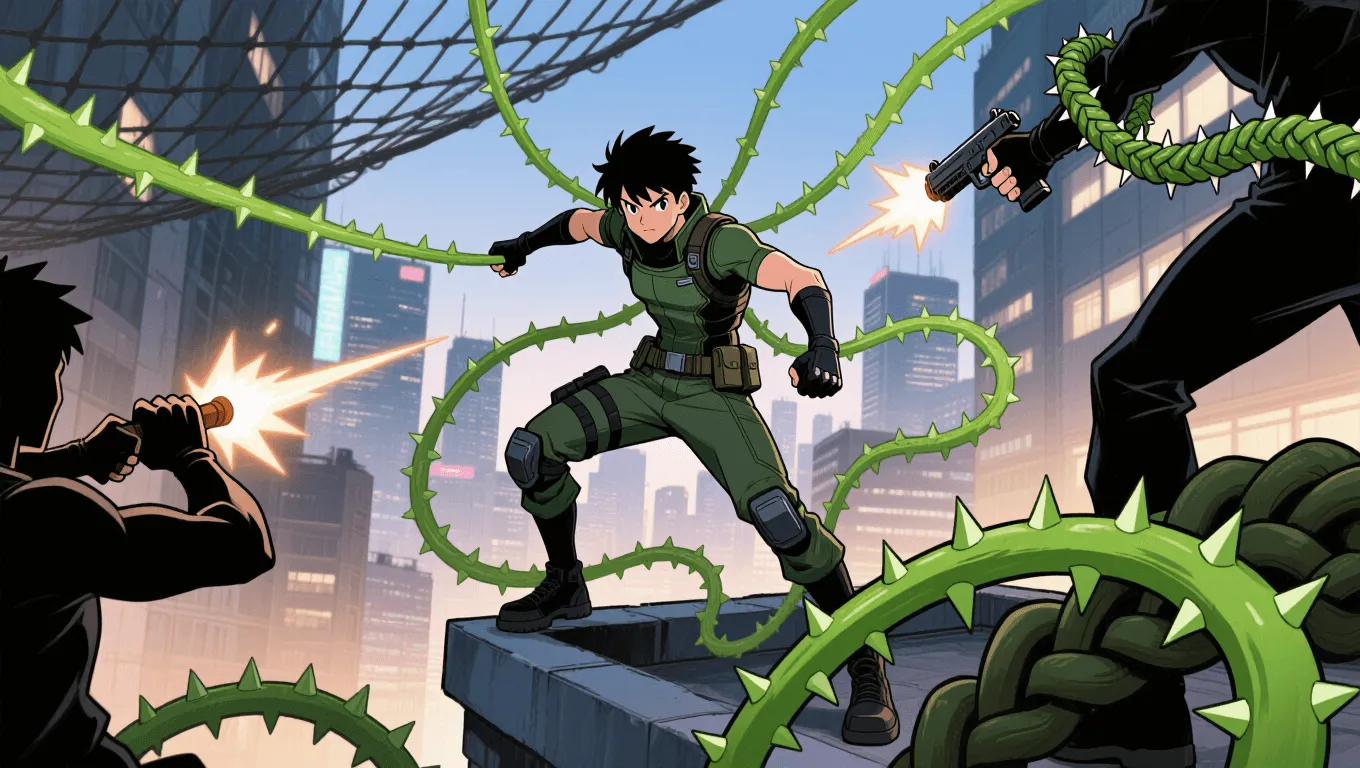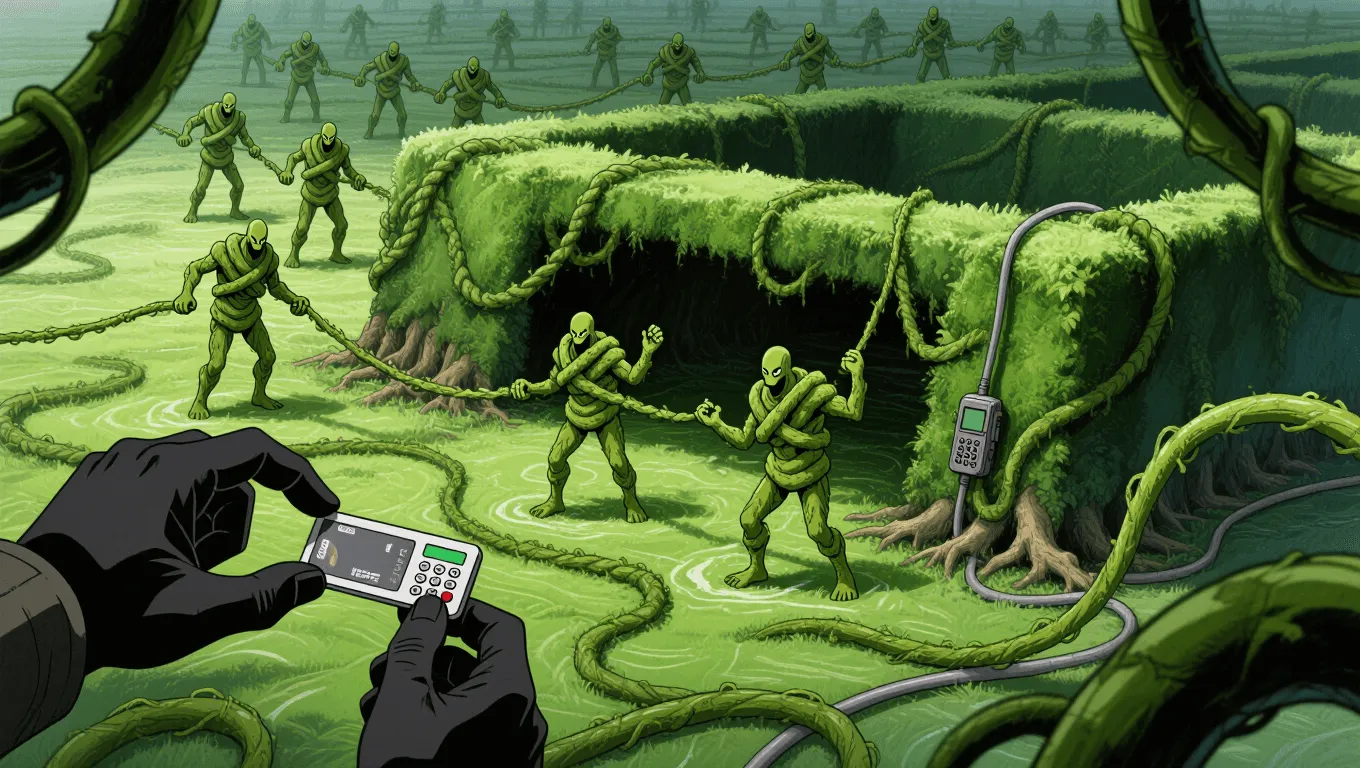Vine Whip

Vine Whip Video Demo 🎬
Table of Contents
What Is Vine Whip
Vine Whip is a nature-based superpower that manifests as fast, whip-like vines extending from the ground, nearby foliage, or the user’s body. As the name suggests, Vine Whip excels at striking, binding, and disarming targets at medium range while leveraging plant manipulation principles (often called chlorokinesis). Whether conjured as living ropes or animated from existing creepers, the power delivers flexible control, rapid entanglement, and thorned restraint—perfect for battlefield control without lethal force.
At its core, Vine Whip sits between offense and utility. It can lash opponents, yank weapons, pull levers, swing the user across gaps, and create instant barricades. In worldbuilding terms, it often overlaps with broader plant control but focuses on the speed, snap, and precision of whip mechanics rather than slow botanical growth. If you’re exploring similar abilities, browse the full catalog in the Superpower Wiki or discover a new idea with the random superpower generator.
Core Abilities of Vine Whip
Rapid Lash
The signature move: a high-speed, flexible strike that stings, trips, or knocks back. With practice, users vary lash width—from a slender, cable-fast tendril for speed to a thicker, club-like vine for impact control.
Entanglement & Binding
Vines coil around limbs, torsos, or gear to immobilize. Thorned variants increase pain compliance, while smooth vines prevent unnecessary injury during captures. Advanced users can braid multiple tendrils to form cuffs or woven harnesses.
Disarm & Trip Control
Hooked tendrils catch hilts, gun barrels, or wrists to wrench equipment free. Low sweeps snare ankles for reliable takedowns, creating openings for allies.
Grappling & Traversal
Vines anchor to architecture, trees, or rock faces to create swing lines, ziplines, or climbing assists. In urban spaces, this offers Spider-style mobility without webbing; in forests, it’s almost silent.
Shielding & Warding
Dense vine mats can be fanned into a momentary shield against projectiles or shrapnel. Thorn hedges act as deterrents, establishing quick “no-go” zones.
Sensory Feedback (Advanced)
Experienced users “feel” tension, vibration, and contact points through their vines, granting tactile awareness beyond line of sight—useful for detecting trip hazards, hidden foes, or fragile structures.
Application / Tactical Advantages in Combat
Zone Control and Crowd Management
Vine Whip excels at shaping the battlefield. Users can fence off choke points, stagger enemy lines, and control spacing with sweeps, binds, and trip hazards. It’s a humane answer to riot control and capture missions.
Non-Lethal Compliance
Compared to bladed or ballistic powers, Vine Whip offers precise incapacitation without permanent harm. Cuffed binds, limb-only restraints, and padded wraps make it ideal for rescue teams and heroes with strict codes.
Weapon Denial
Quick tendril hooks can flick safeties, jam triggers, or wrench magazines from firearms. Against melee specialists, vine loops neutralize reach by knotting wrists or ankles.
Mobility and Positioning
In mixed terrain, Vine Whip users reposition at will—vault up balconies, swing over barricades, or rappel down vertical shafts. This constant angle-shifting frustrates snipers and slows pursuers.
Rescue and Field Engineering
From lowering civilians to stabilizing debris, vines function as emergency rigging. Braided ropes can haul vehicles, lift beams, or create makeshift stretchers—turning a combat skill into a lifesaving toolkit.
Psychological Pressure
A blooming wall of thorns or a sudden tightening coil is intimidating. The threat of painless but absolute restraint discourages escalation and can end fights before they begin.
Level: Level 1 🏙️, Level 2 🌇, Level 3 🌃
Level 1 — Sapling Control

Profile: New users manifest one or two tendrils reaching 3–5 meters. Control is line-of-sight and single-task: lash or bind.
Capabilities:
-
Basic whip strikes with light bruising force
-
Simple ankle trips and single-limb binds
-
Short swings or assisted jumps
Training Goals: Practice tip control (precision striking of small targets), learn safe restraint knots, and condition core/shoulders for grappling swings.
Level 2 — Thicket Tactician

Profile: Multiple vines deployed simultaneously, 8–12 meters reach, with split-focus control.
Capabilities:
-
Multi-point entanglement (two-limb bind + disarm)
-
Thorn modulation (retractable barbs for compliance without tearing)
-
Quick barricades and woven shields
-
Reliable urban traversal and mid-air course correction
Training Goals: Develop sensory feedback; drill seamless transitions between strike, bind, and swing; learn braided constructs (nets, cuffs, slings).
Level 3 — Verdant Mastery

Profile: High-density vine fields with semi-autonomous tendrils, 15–25 meters or more depending on environment and stamina.
Capabilities:
-
Area denial with reactive hedges and snare carpets
-
Fine motor manipulation (pickpocket a keycard, press keypads, tie complex knots)
-
Remote tactile “radar” via vibration sense
-
Temporary golems or animated braids for delegated tasks
Training Goals: Sustain broad fields without fatigue, integrate tactical comms with team movements, and master environmental synthesis (turning cables, hoses, or roots into functionally “vine-like” extensions where flora is scarce).
Limitations of Using the Vine Whip
-
Environment Dependence: In barren zones (deserts, glaciers, sterile interiors), conjuration demands greater energy. Without ambient flora, range and thickness drop.
-
Material Fatigue: Organic vines fray, dry, or snap under repeated stress. Without hydration or reinforcement, tensile strength degrades during extended missions.
-
Line-of-Sight & Focus: While advanced users can split attention, each additional tendril taxes concentration. Complex multi-binds risk slippage if focus breaks.
-
Weight Limits: Heavy lifts require braided supports and anchoring. Misjudging load can cause catastrophic whipback.
-
Collateral Growth: Overzealous thorn use or invasive rooting can damage property or ecosystems, especially in protected habitats.
-
Counter-Terrain: Razor wire, rotating machinery, and abrasive surfaces shear vines; narrow ventilation shafts restrict swing paths.
Weakness Against What Other Superpowers
Pyrokinesis / Fire Manipulation
Heat desiccates and chars vines, destroying flexibility and tensile strength. Flame curtains also block traversal routes and burn away hedges.
Cryokinesis / Cold Manipulation
Freezing saps elasticity, turning vines brittle and prone to snapping. Frosted surfaces further reduce grip on targets and anchor points.
Acid or Corrosion Generation
Caustics dissolve organic fibers rapidly, eating through bindings and braids. Even splash exposure can undermine structural integrity.
Electrokinesis
Wet or sap-rich vines conduct electricity; a targeted surge can travel along the tendril to stun the user or fry sensory feedback.
Telekinesis and Force Bursts
Raw kinetic shoves tear binds loose, while precise telekinetic blade-edges slice tendrils mid-coil.
Blade or Metal Manipulation
Ranged metallokinetic blades and micro-wires shear vines as they approach, forcing users to stay at maximum range or change angles constantly.
Plant Rot / Decay Inducement
Entropy-based powers accelerate wilt and rot, collapsing elaborate constructs and hedges within seconds.
Synergistic Power Combos
Chlorokinesis (Broad Plant Control)
Pairing Vine Whip with full plant growth control multiplies options: instant regrowth, thicker cords, living bridges, and auto-knotting restraints that tighten on struggling.
Hydrokinesis
Moisture management prevents fiber brittleness, increases elasticity, and enables slick “hydro-vines” that slide through tight gaps or constrict with hydraulic pressure.
Geokinesis
Earth spikes and trenches channel enemies into pre-seeded snare lanes. Stone anchors make vine winches and barricades far sturdier.
Toxin or Pollen Generation
Lacing binds with sleep pollen, irritants, or mild venoms creates soft-control fields that end fights quickly without permanent harm.
Camouflage / Illusion
Visual veil + silent vines equals ambush supremacy. Camouflage hides tendrils along natural lines; illusions misdirect targets into pre-set snares.
Beast or Insect Communication
Allied fauna ferry lines, carry micro-vines, or distract foes while tendrils strike. Pollinators can also spread seed-pods that sprout into fresh anchors.
Kinetic Dampening / Force Fields
Protective bubbles let the user swing through hazardous debris while vines operate inside the shield—great for rescue under fire.
Tech Augmentation
Reinforced bio-cables, smart-fiber braids, or gauntlet spools provide quick-deploy tendrils when flora is scarce, keeping Vine Whip viable in sterile facilities.
Known Users
-
Poison Ivy (DC Comics) — A master of plant-based control who frequently restrains foes with animated creepers and thorned binds. Read more about Pamela Isley.
-
Groot (Marvel Comics) — Utilizes extended limbs and growing tendrils for binding, shielding, and traversal in team operations. Groot character profile.
-
Swamp Thing (DC Comics) — Commands the Green to form complex vine constructs for protection, transport, and overwhelming restrains. Swamp Thing overview.
-
Bulbasaur Line (Pokémon, manga) — Depictions in manga and comics showcase swift tendril lashes for disarm and capture, embodying the classic whip mechanic.
Looking for adjacent abilities, training paths, or counters? Explore the full Superpower Wiki or roll a fresh concept with the random superpower generator.
